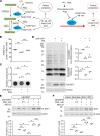Phenylbutyrate modulates polyamine acetylase and ameliorates Snyder-Robinson syndrome in a Drosophila model and patient cells
- PMID: 35801587
- PMCID: PMC9310527
- DOI: 10.1172/jci.insight.158457
Phenylbutyrate modulates polyamine acetylase and ameliorates Snyder-Robinson syndrome in a Drosophila model and patient cells
Abstract
Polyamine dysregulation plays key roles in a broad range of human diseases from cancer to neurodegeneration. Snyder-Robinson syndrome (SRS) is the first known genetic disorder of the polyamine pathway, caused by X-linked recessive loss-of-function mutations in spermine synthase. In the Drosophila SRS model, altered spermidine/spermine balance has been associated with increased generation of ROS and aldehydes, consistent with elevated spermidine catabolism. These toxic byproducts cause mitochondrial and lysosomal dysfunction, which are also observed in cells from SRS patients. No efficient therapy is available. We explored the biochemical mechanism and discovered acetyl-CoA reduction and altered protein acetylation as potentially novel pathomechanisms of SRS. We repurposed the FDA-approved drug phenylbutyrate (PBA) to treat SRS using an in vivo Drosophila model and patient fibroblast cell models. PBA treatment significantly restored the function of mitochondria and autolysosomes and extended life span in vivo in the Drosophila SRS model. Treating fibroblasts of patients with SRS with PBA ameliorated autolysosome dysfunction. We further explored the mechanism of drug action and found that PBA downregulates the first and rate-limiting spermidine catabolic enzyme spermidine/spermine N1-acetyltransferase 1 (SAT1), reduces the production of toxic metabolites, and inhibits the reduction of the substrate acetyl-CoA. Taken together, we revealed PBA as a potential modulator of SAT1 and acetyl-CoA levels and propose PBA as a therapy for SRS and potentially other polyamine dysregulation-related diseases.
Keywords: Genetic diseases; Genetics; Lysosomes; Polyamines; Therapeutics.
Conflict of interest statement
Figures







Similar articles
-
Difluoromethylornithine rebalances aberrant polyamine ratios in Snyder-Robinson syndrome.EMBO Mol Med. 2023 Nov 8;15(11):e17833. doi: 10.15252/emmm.202317833. Epub 2023 Sep 13. EMBO Mol Med. 2023. PMID: 37702369 Free PMC article.
-
(R,R)-1,12-Dimethylspermine can mitigate abnormal spermidine accumulation in Snyder-Robinson syndrome.J Biol Chem. 2020 Mar 6;295(10):3247-3256. doi: 10.1074/jbc.RA119.011572. Epub 2020 Jan 29. J Biol Chem. 2020. PMID: 31996374 Free PMC article.
-
Polyamine Homeostasis in Snyder-Robinson Syndrome.Med Sci (Basel). 2018 Dec 7;6(4):112. doi: 10.3390/medsci6040112. Med Sci (Basel). 2018. PMID: 30544565 Free PMC article.
-
Spermidine/spermine-N(1)-acetyltransferase: a key metabolic regulator.Am J Physiol Endocrinol Metab. 2008 Jun;294(6):E995-1010. doi: 10.1152/ajpendo.90217.2008. Epub 2008 Mar 18. Am J Physiol Endocrinol Metab. 2008. PMID: 18349109 Review.
-
Catabolism of polyamines.Amino Acids. 2004 Jun;26(3):217-33. doi: 10.1007/s00726-004-0070-z. Epub 2004 Apr 20. Amino Acids. 2004. PMID: 15221502 Review.
Cited by
-
Two New Cases of Bachmann-Bupp Syndrome Identified through the International Center for Polyamine Disorders.Med Sci (Basel). 2023 Apr 4;11(2):29. doi: 10.3390/medsci11020029. Med Sci (Basel). 2023. PMID: 37092498 Free PMC article.
-
Difluoromethylornithine rebalances aberrant polyamine ratios in Snyder-Robinson syndrome.EMBO Mol Med. 2023 Nov 8;15(11):e17833. doi: 10.15252/emmm.202317833. Epub 2023 Sep 13. EMBO Mol Med. 2023. PMID: 37702369 Free PMC article.
-
Uncovering the roles of Mycobacterium tuberculosis melH in redox and bioenergetic homeostasis: implications for antitubercular therapy.mSphere. 2024 Apr 23;9(4):e0006124. doi: 10.1128/msphere.00061-24. Epub 2024 Apr 2. mSphere. 2024. PMID: 38564709 Free PMC article.
-
Impaired polyamine metabolism causes behavioral and neuroanatomical defects in a mouse model of Snyder-Robinson syndrome.Dis Model Mech. 2024 Jun 1;17(6):dmm050639. doi: 10.1242/dmm.050639. Epub 2024 May 9. Dis Model Mech. 2024. PMID: 38463005 Free PMC article.
-
Repurposing With Purpose: Treatment of Bachmann-Bupp Syndrome With Eflornithine and Implications for Other Polyaminopathies.Am J Med Genet C Semin Med Genet. 2025 Apr 1:e32138. doi: 10.1002/ajmg.c.32138. Online ahead of print. Am J Med Genet C Semin Med Genet. 2025. PMID: 40167220
References
Publication types
MeSH terms
Substances
Supplementary concepts
Grants and funding
LinkOut - more resources
Full Text Sources
Molecular Biology Databases
Research Materials

